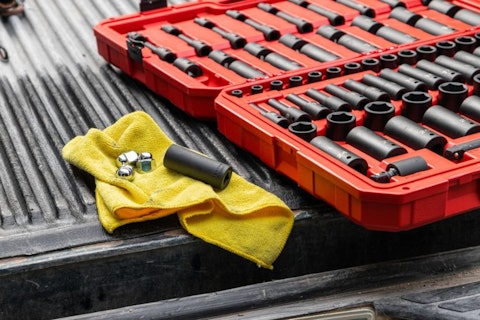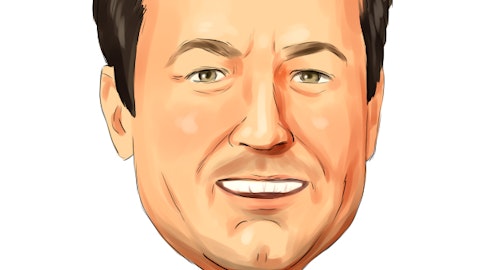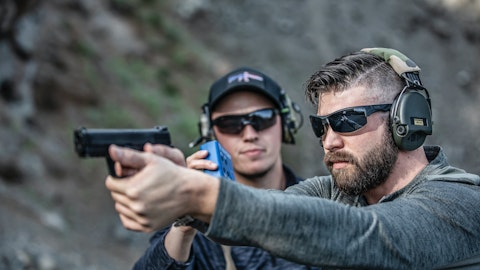Sportsman’s Warehouse Holdings, Inc. (NASDAQ:SPWH) Q3 2022 Earnings Call Transcript December 7, 2022
Sportsman’s Warehouse Holdings, Inc. beats earnings expectations. Reported EPS is $0.34, expectations were $0.29.
Operator: Greetings and welcome to the Sportsman’s Warehouse Third Quarter 2022 Earnings Call. And as a reminder, this conference call is being recorded. And it is now my pleasure to introduce to you, Riley Timmer, VP of IR. Thank you, Riley. You may begin.
Riley Timmer: Thank you, operator. With me on the call today is Jon Barker, Chief Executive Officer and Jeff White, Chief Financial Officer of Sportsman’s Warehouse. I will now remind everyone of the company’s Safe Harbor language. The statements we make today will contain forward-looking statements within the meaning of the Private Securities Litigation Reform Act of 1995, which includes statements regarding our expectations about our future results of operations, demand for our products and growth of our industry. Actual future results may differ materially from those suggested in such statements due to a number of risks and uncertainties, including those described under the caption Risk Factors in the company’s most recent Form 10-K and the company’s other filings made with the SEC.
We will also disclose non-GAAP financial measures during today’s call. Definitions of such non-GAAP measures as well as reconciliations to the most directly comparable GAAP financial measures are provided as supplemental financial information in our press release included as Exhibit 99.1 to the Form 8-K we finished to the SEC today, which is also available on the Investor Relations section of our website at sportsmans.com. I would also like to note that today’s materials include an earnings conference call PowerPoint presentation, which is available at sportsmans.com in the Investor Relations section of the website. You can utilize this deck as a reference with today’s prepared remarks. I will now turn the call over to Jon, our CEO.
Jon Barker: Thank you, Riley. Good afternoon, everyone and thank you for joining us today. I will begin by reviewing the highlights of our third quarter performance, comment on the current trends we are seeing with our consumers and review key elements of the growth strategy for our omnichannel business model. Following my comments, Jeff will provide additional details on our third quarter results as well as discuss our outlook for the fourth quarter and full year 2022. Finally, we will open up the call for questions. Turning first to our performance. We were pleased with our third quarter results, with net sales in line with guidance and EPS above the high-end of our estimate. These results reflect our disciplined efforts and efficient management of the business as we carefully navigate the challenging macroeconomic environment.
Similar to prior quarters, on our call today, we will provide comparisons to our 2019 results to highlight the strength of the business and market share gains achieved. In the third quarter, same-store sales performed in line with our guidance, down 15% compared to the third quarter of 2021. When comparing to the third quarter of 2019, same-store sales were up 19.5%. Looking now at our key departments. During the last couple of years, event-driven cycles have elevated sales levels in our hunting and shooting sports department, especially in personal protection firearms. While elevated over pre-pandemic levels, personal protection firearms sales have softened greater than the overall business, putting pressure on the top line when compared with last year.
Offsetting the downward trend in personal protection firearms during the quarter, our hunting rifle category continued to perform well, driven by seasonal demand and our geographic expansion into the Eastern markets. To enhance customer acquisition and retention and keep our competitive advantage, we carry an industry-leading assortment of firearms with a focus of expanding our exclusive partnerships and offerings. The customer response to these unique products continues to be positive proving our right to win with exclusive products. To further leverage our extensive offering and leading industry position, we maintain over 500 federal firearms license dealer partnerships across the U.S., allowing us to serve over 95% of our country’s population.
Comparing our hunting and shooting sports department 2019, it increased nearly 33%. This increase reflects both increased participation and additional market share capture. Ammunition sales remained strong during the quarter as we saw continued improvement with both our in-stock position and assortment. We experienced positive trends on both rimfire and handgun ammo as supply and demand has stabilized in these two key areas. On hunting rifle ammunition, an important element of Q3 seasonal demand, inventory levels improved over the prior year, allowing us to service our customers significantly better than the prior year. During the back half of the quarter, we started to see improvements in shotshell supply. While the domestic manufacturing and supply of shotshells has improved and the recent progress is encouraging, there is still progress to be made before we reach healthy in-stock levels.
Comparing ammunition sales to 2019, we were up 30.5% in the third quarter. With industry-leading assortment and expertise, we remain confident in our positioning within our hunting and shooting sports department and look to capture additional market share given the shift over the last 2 years to greater outdoor participation, including $16 plus million first-time firearm owners. Moving on to other areas of the business, our apparel and footwear departments continue to outperform in relation to the overall performance of the business. Our improved in-store and online assortment, expanded vendor base and omnichannel capabilities provide customers greater opportunities to find the merchandise they are looking for. This quarter, we saw strong results in both women’s and men’s outerwear.
While it’s a small portion of the business, this is an emerging growth category in both branded and private label. Comparing our results to 2019, apparel is up 21% and footwear is up 17%. During the quarter, we launched a new technical camouflage pattern within our Killik premium hunting brand. Early indicators suggest a greater level of penetration from the sales of this new product, which carries a higher overall gross margin. Also launched during Q3 was our first private brand hunting boot from Rustic Ridge. This new boot with an improved overall margin is seeing strong sell-through both online and in stores. Our private brands offer fill-in products such as these, which are resonating with our customers. They also provide features and benefits that are similar to our core hunting brands, while at a lower price point.
These two examples support the strategic roadmap to reach our 2025 target of 7% to 9% private brand penetration. Turning now to our omnichannel development. Our e-commerce-driven business continues to grow and outpace the overall company with strong performance again during the third quarter. With total penetration now in the mid to high-teens, our e-commerce-driven sales increased 3.7% over Q3 of last year. This was primarily driven by strong sales from ammunition, apparel and scopes and optics. The investments made in technology over the last few years allow us to leverage our existing store footprint and inventory to better service our customer. We are utilizing more effective targeted marketing and digital ad campaigns to leverage our growing customer databases and maximize the lifetime value of these customers.
Our omnichannel platform continues to provide increased leverage on our inventory. The platform’s ability to utilize existing store inventory as well as our rapidly growing drop ship network allows us to better service our customers with increased product assortment, while at the same time, minimizing the capital investment required. During the third quarter, over 70% of our online sales were serviced with inventory from our stores or through drop ship partners. These capabilities provide us with greater confidence in achieving our 2025 target of 25% e-comm penetration. Turning now to real estate. During the third quarter, we opened 3 new stores. We also opened our final 2 stores for the year during the month of November. This now brings the number of new stores opened in 2022 to 9 total, for a total of 131 stores in 30 states.
Our unique approach to new store development using our flexible store format provides us the opportunity to reach consumers in all markets. The size of box for the 9 new stores opened during 2022 ranges from approximately 9,000 square feet to nearly 40,000 square feet. This is a strategic advantage that is unmatched by our competition. I am proud of the team for successfully managing supply chain constraints, construction delays and other external factors to successfully open 9 new stores during this year. As we look ahead, our funnel of real estate remains robust and we are moving with discipline and rigor to accelerate the growth of our store footprint. Our funnel as we sit here today is well over 100 locations and we see a path to our target of 190 to 210 total stores in the fleet by the end of fiscal 2025.
We expect continued expansion into states such as Florida and California with new stores planned in under-penetrated areas of the Midwest, including the state of Wisconsin. Regarding the fourth quarter, we are pleased with the underlying strength of the core Sportsman’s business as we continue to make progress on our key growth strategies. While we continue to face tough macroeconomic consumer headwinds, we feel confident about our competitive positioning and the investments made over the last years to successfully serve our customers. While we have a long way to go in the season, early Q4 indicators are positive, including Black Friday being the single largest day in customer visits and sales in the history of the company, suggesting that the holiday selling season is off to a good start.
I will now turn the call over to Jeff to review our third quarter results and discuss our Q4 and full year 2022 guidance.
See also 20 Countries That Produce the Most Electric Power and 15 Countries That Produce the Most Oil.
Jeff White: Thank you, Jon. I will begin my remarks today with a review of our third quarter fiscal 2022 financial results. I will then review our outlook for the fourth quarter and full year 2022. Net sales for the third quarter of fiscal 2022 were $359.7 million compared to $401 million in the third quarter of 2021, a decrease of 10.3% over the prior year period, but in line with our guidance range. This decrease was primarily driven by lower demand from consumer inflationary pressures and recession concerns partially offset by the opening of 11 new stores since October 30, 2021. Same-store sales decreased 15% in the quarter compared with the same quarter of the prior year, which was in the middle of our guided range. This decrease was primarily driven by lower sales demand across our product categories due to inflationary pressures and tough year-over-year comps.
Comparing our same-store sales results to the third quarter of 2019, we saw an increase of 19.5%. We saw significant increases in most categories as compared to Q3 2019, with hunting up 32.9%, apparel up 21.2%, footwear up 17.3%, camping up 6.7% and optics electronics and accessories, up 4.8%. These positive pre-pandemic same-store sales trends provide us continued confidence in the health of our industry and of our business. Third quarter 2022 gross profit was $120.8 million compared to $129.6 million in the third quarter of 2021. Gross margin percentage was 33.6% for the quarter, an improvement of 130 basis points versus the prior year comparable period. This year-over-year improvement as a percentage of net sales was due to improved trends in shipping, freight and logistical expenses, increased product margins and favorable product mix.
SG&A expense of $102.3 million for the third quarter of 2022 was an increase of $2.3 million or 2.3% compared to the third quarter of the prior year. As a percentage of net sales, SG&A expense increased to 28.4% compared to 24.9% in the third quarter of the prior year. This increase was primarily driven by the resumption of our normal marketing and travel-related activities during the quarter and higher rent and depreciation mostly related to our new stores opened during the year. We will stay disciplined and continue to closely manage our non-fixed operating cost on a store-by-store basis to keep expenses in balance with our sales. Income from operations was $18.5 million in the third quarter of 2022 compared to $29.6 million in the prior year period, a decrease of $11.1 million.
Net income for the third quarter was $12.9 million or $0.33 per diluted share as compared to net income of $21.9 million or $0.49 per diluted share in the prior year period. Adjusted net income in the third quarter of 2022 was $13.1 million or $0.34 per adjusted diluted share compared to adjusted net income of $22.7 million or $0.51 per adjusted diluted share in the third quarter of the prior year. Adjusted EBITDA for the third quarter of 2022 was $29.1 million or 8.1% of net sales compared to $39.3 million or 9.8% of net sales in the prior year period. Turning to our balance sheet and liquidity. Third quarter 2022 ending inventory was $485.2 million compared to $437.4 million at the end of the second quarter of 2022. This quarter-over-quarter increase is primarily due to the recent opening of five new stores and build up for the holiday shopping season.
Looking at our inventory on a per square foot basis compared to the third quarters of 2017, €˜18 and €˜19, we are within the range of those periods with approximately $95 of inventory per square foot. We will continue to closely manage our inventory levels to ensure we have the right mix of merchandise to better service the needs of our customers. Looking at cash flow for the first 9 months of 2022, cash provided by operating activities was $14.5 million versus cash used in operating activities of $78.3 million for the first 9 months of 2021. This increase in our cash inflows was due to the normalization of our inventory levels versus the buildup needed during the prior year 9-month period. Our liquidity continues to be strong as we ended the third quarter of 2022 with $120.2 million outstanding on our line of credit.
We have approximately $193 million available for borrowings under our credit facility, and we will continue to manage our borrowings to ensure we stay within our goal of less than 1.5x leverage. During the third quarter, we repurchased 1.2 million shares in the open market. This was a return of $10.4 million of capital to our shareholders. Year-to-date, we have repurchased a total of 6.5 million shares for a return of capital of $62.4 million. At the end of the quarter, we have $12.6 million remaining under the authorized share repurchase program, and we will continue to opportunistically execute in the open market. Turning now to our guidance. Starting with our net sales outlook, we estimate fourth quarter net sales to be in the range of $370 million to $385 million.
This implies our full-year 2022 sales will be in the range of $1.39 billion to $1.4 billion. Same-store sales in the fourth quarter of 2022 are anticipated to be in the range of down 13% to down 9% and earnings per share for the fourth quarter of 2022 is expected to be in the range of $0.25 to $0.35 per diluted share. This implies that our full-year 2022 EPS will be in the range of $0.98 to $1.08 per diluted share. To give you some additional perspectives on the quarter and the full-year, given the ongoing global uncertainties, our forecast for Q4 includes continued inflationary pressure and difficult macroeconomic conditions, which is putting pressure on consumers. We will continue to control costs and carefully manage our variable operating expenses without compromising our industry-leading customer service levels with a disciplined approach to spending.
We remain confident in our ability to achieve our target of high single-digit adjusted EBITDA margins for the full-year. Looking now to 2023, as Jon mentioned in his remarks earlier, we see significant expansion opportunities in front of us and are accelerating our new store growth over the next 3 years. Our current view for 2023 is to open between 13 and 18 new stores during the year. This would be the highest number of new stores opened in any single year. This concludes our prepared remarks today. With that, I will now turn the call back over to the operator to facilitate any questions.
Q&A Session
Follow Sportsman's Warehouse Holdings Inc. (NASDAQ:SPWH)
Follow Sportsman's Warehouse Holdings Inc. (NASDAQ:SPWH)
Operator: Thank you. And our first question comes from the line of Ryan Sigdahl with Craig-Hallum. Please proceed with your question.
Unidentified Analyst: This is Will on for Ryan. Thanks for taking our question. First, I wanted to touch on Black Friday. It sounds like it was pretty good for you guys. How did that compare to your expectations? Were there any segments that stood out? And how do you compare it for brick-and-mortar and e-comm?
Jon Barker: Hey Will, it’s Jon. Thanks for the question. As we referenced in my script, Black Friday was the single largest day in the history of the company when you think about visitors through our website store combined as well as gross sales from the two combined. I actually saw a nice lift across the board in the business. I will tell you that the consumer during this holiday season appears to be promotionally item-driven up to this point. So while we’ve seen our competitors promote in a more normal cadence as compared to more of a 2018, 2019 time frame, the basket of the consumer tends to be a little more focused on promotional items. So we’re keeping close track on that, and we believe that’s contributed by the fact that the consumer continues to see inflationary pressures on disposable income.
Unidentified Analyst: That’s great. Thanks for the color. Maybe a quick follow-up on that how did sort of promotions and discounting look like during the quarter? And I do think that’s going to trend as we go into €˜23 here?
Jon Barker: Yes. Again, as we think about this end of Q3 and the holiday season, we expected the market to return to a more normal cadence on promotion, referring back to pre-COVID. And that’s what we’ve experienced, our primary competitors in the outdoor sporting goods industry, a return to their normal promotional cadence. There were some key items to drive traffic that we saw this year we hadn’t seen in the last couple of years. We were prepared in a similar manner with our planning, and we expect that to continue in again, a more normal cadence through the end of Q4. We’ve provided some insights into inventory. We don’t see a high pressure as we sit here today for us to promote to drive inventory through the system. So we will maintain rigor in our promotional cadence to ensure that we acquire and retain our consumers as priority one, while maintaining the margin profile that we believe is important for running this business in the long-term.
Unidentified Analyst: Great. And then one last one if I might. I wanted to ask on private label. It sounds like you guys are doing pretty well with that. How do you think about brand assortment and mix as we head into €˜23 here?
Jon Barker: Will, is it specific to our private label brands? Is that €“ was that your question? I want to make sure I get it clear.
Unidentified Analyst: Yes.
Jon Barker: So again, as we think about evolving the strategy on our private label, it was a path to high single-digit penetration by the end of 2025. The apparel and footwear categories are the two areas that we’re most focused on in serving our consumers with features and benefits at a value they can’t find in some of the brands in the market today. It does not mean we will displace the key brands that our customers come to Sportsman’s Warehouse looking for, but we will complement those brands on the good, better, best strategy and a broader assortment. Speaking specifically into the hunting camouflage category, our Rustic Ridge brand, which is an entry-level value-based product connects extremely well with the first-time consumer that is more of a budget for their camouflage, whereas the Killik brand is on the best side of camouflage, higher price point, but also provides the technical fabrics and the key features and benefits that someone needs when they are spending multiple days on the mountain.
So we feel like those two brands are a good indicator of what’s possible in areas where we can continue to evolve and develop new product and gain market share, both in private label, but also against the overall market.
Unidentified Analyst: Alright. Thanks, guys. Good luck.
Jon Barker: Thanks, Will.
Operator: And our next question comes from the line of Eric Wold with B. Riley Securities. Please proceed with your question.
Eric Wold: Thanks. Good afternoon, guys. Two questions. I guess, two questions, they have a couple of parts each. On the inventory, you noted that it’s relatively in line with where you were in €˜17, €˜18, €˜19 on a per square foot basis. Kind of more generally, any areas of the store where you feel you’re a little light or a little heavy? And then how would you characterize your restocking patterns OEMs right now? Are you still more on the cautious side or are you generally restocking along with sales?
Jeff White: Yes, Eric Wold, this is Jeff. Thanks for the question. With inventory, as we look at the total inventory, if you compare it to where we were year-over-year versus Q3 of last year as we walked into the holiday, I think the numbers are, we’re really only up 13% in total inventory dollars. We have roughly 6% more square feet than we did at this time last year, not taking into account the inflationary impacts on inventory. As I think about the totality of those numbers, our inventory is very healthy. Are there pockets here and there where we have issues that bubble up? Absolutely. Every retailer does. But as we take a step back and look at the entire inventory, we’re very pleased with what the team has done in managing that.
Much like we spoke to earlier in the year, as we see pockets where there are softness, we make strategic moves to pull back in those areas. An example of that would have been pellet grills early in the year. We called the softness in that sometime in Q1, Q2 and we right-sized the inventory and got out of the areas that we’re seeing softness in demand. And as we sit here today, we’re very comfortable with that position of inventory. That type of mentality and rigor is spread across our entire book of inventory. We are looking at everything. So as we think about throughput from the vendors and suppliers, we’re going to continue to manage the areas where we’re seeing softness. We’re going to reduce the flow of inventory in those areas. But on the other side of that, in areas that we’re continuing to see strength, consumables would be a highlight there.
We can’t run out of the product that the consumer is still using as they participate in outdoor activities.




